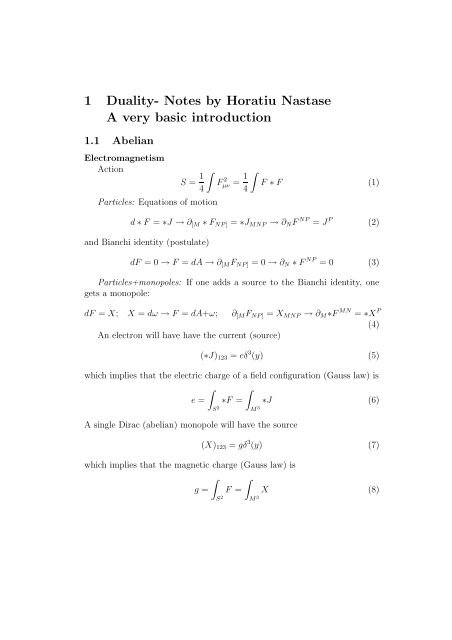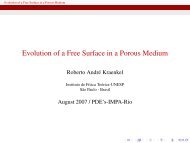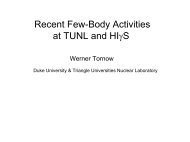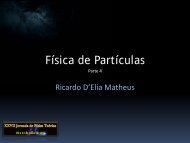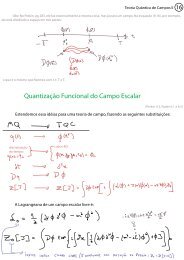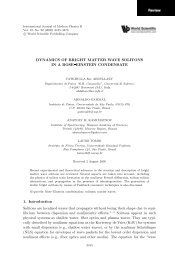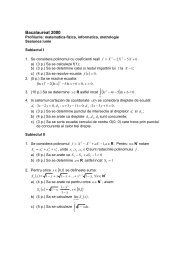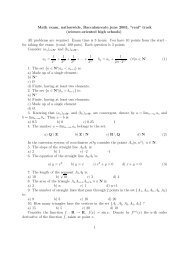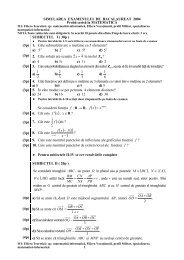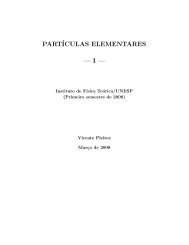1 Duality- Notes by Horatiu Nastase A very basic introduction
1 Duality- Notes by Horatiu Nastase A very basic introduction
1 Duality- Notes by Horatiu Nastase A very basic introduction
You also want an ePaper? Increase the reach of your titles
YUMPU automatically turns print PDFs into web optimized ePapers that Google loves.
1 <strong>Duality</strong>- <strong>Notes</strong> <strong>by</strong> <strong>Horatiu</strong> <strong>Nastase</strong><br />
A <strong>very</strong> <strong>basic</strong> <strong>introduction</strong><br />
1.1 Abelian<br />
Electromagnetism<br />
Action<br />
S = 1 4<br />
∫<br />
F 2 µν = 1 4<br />
∫<br />
F ∗ F (1)<br />
Particles: Equations of motion<br />
d ∗ F = ∗J → ∂ [M ∗ F NP ] = ∗J MNP → ∂ N F NP = J P (2)<br />
and Bianchi identity (postulate)<br />
dF = 0 → F = dA → ∂ [M F NP ] = 0 → ∂ N ∗ F NP = 0 (3)<br />
Particles+monopoles: If one adds a source to the Bianchi identity, one<br />
gets a monopole:<br />
dF = X; X = dω → F = dA+ω; ∂ [M F NP ] = X MNP → ∂ M ∗F MN = ∗X P<br />
An electron will have have the current (source)<br />
(4)<br />
(∗J) 123 = eδ 3 (y) (5)<br />
which implies that the electric charge of a field configuration (Gauss law) is<br />
∫ ∫<br />
e = ∗F = ∗J (6)<br />
S 2 M 3<br />
A single Dirac (abelian) monopole will have the source<br />
(X) 123 = gδ 3 (y) (7)<br />
which implies that the magnetic charge (Gauss law) is<br />
∫ ∫<br />
g = F = X (8)<br />
S 2 M 3
Here we have used the generalized Gauss formula<br />
∫ ∫<br />
dA = A (9)<br />
M<br />
The electric charge of an electron and the magnetic charge of another object<br />
are related <strong>by</strong> the Dirac quantization condition<br />
Now we have manifest duality:<br />
∂M<br />
eg = 2πn (10)<br />
F → ∗F ; e → g; ∗J → X (11)<br />
P-form “electromagnetism” (abelian): Action<br />
∫<br />
S =<br />
F 2<br />
(d+1)<br />
2(d + 1)!<br />
p=d-1-brane+ generalized monopoles: Equations of motion<br />
(12)<br />
d(∗F ) D−d−1 = (∗J) D−d (13)<br />
and “Bianchi identities”<br />
dF d+1 = X d+2 = dω d+1 → F d+1 = dA d + ω d+1 (14)<br />
The p-brane singular electrically charged object (analog of electron) has<br />
(∗J) 1...D−d = e d δ D−d (y) (15)<br />
whereas the D-d-3 brane singular magnetically chaged object (analog of the<br />
monopole) has<br />
X 1...D+2 = f D−d−2 δ d−2 (y) (16)<br />
and the charges are defined <strong>by</strong> the Gauss law<br />
∫<br />
∫<br />
e d = (∗F ) D−d−1 = ∗J D−d (17)<br />
S D−d−1 M D−d<br />
and the magnetic Gauss law<br />
∫<br />
∫<br />
g D−d−2 = F d+1 = X d+2 (18)<br />
S d+1 M d+2
obeying the generalized Dirac quantization condition<br />
e d g D−d−2 = 4π n 2<br />
(19)<br />
We have the same manifest duality as in the particle case.<br />
Dirac monopole<br />
Analogous to the static electric charge<br />
⃗E =<br />
we have the Dirac monopole configuration<br />
⃗B =<br />
e ˆr (20)<br />
4πr2 g ˆr (21)<br />
4πr2 However, since now F = dA + ω, and F = dA only locally (and away from<br />
the singularity at x=0), we can’t define A globally, only on patches we can<br />
write ⃗ B = ∇ × ⃗ A. We can write for instance in the northern and southern<br />
hemispheres of 3d space<br />
⃗A N =<br />
g<br />
4πr<br />
⃗A S = − g<br />
4πr<br />
1 − cos θ<br />
⃗e φ<br />
sin θ<br />
1 + cos θ<br />
⃗e φ (22)<br />
sin θ<br />
We see that A ⃗ N is well defined over the whole space except at the South pole<br />
θ = π, whereas A ⃗ S is well defined over the whole space except at the North<br />
pole θ = 0.<br />
This is a particular case of the statement that there is always a so-called<br />
“Dirac string” singularity, extending from the source to infinity, if we try to<br />
write down a globally defined gauge field. For A ⃗ N it is the South pole of<br />
space (for varying r), and for A ⃗ S it is the North pole of space (for varying<br />
r). The Dirac string thus is not physical, and can be moved around <strong>by</strong> gauge<br />
transformations. When matching A’s valid on two different patches of space,<br />
like A ⃗ N and A ⃗ S , we get a gauge transformation in between them, here<br />
Then the magnetic charge is<br />
∫<br />
g = Bd ⃗ S ⃗ =<br />
∫S 2<br />
⃗A N − ⃗ A S = −∇χ;<br />
equator<br />
χ = g<br />
4π φ (23)<br />
∆ ⃗ A · d⃗e = χ(0) − χ(2π) ≠ 0 (24)
where in general, equator can be replaced <strong>by</strong> any curve on which we match.<br />
We see that we can classify the gauge field configurations <strong>by</strong> the magnetic<br />
charges, which are obtained <strong>by</strong> taking maps from an equator of S 2 ∞ to the<br />
U(1) gauge group, formally <strong>by</strong> the first homotopy group (winding number)<br />
Π 1 (U(1)) = Z (25)<br />
In general, we can classify gauge fields defined over a sphere S n (at infinity<br />
or otherwise) <strong>by</strong> the (n-1)th homotopy group<br />
Π n−1 (G) (26)<br />
<strong>by</strong> looking at S n−1 equators of S n and mapping them into G.<br />
Equivalently, one classifies <strong>by</strong> the magnetic charge which is also the first<br />
Chern class<br />
∫<br />
F<br />
c 1 (F ) −<br />
(27)<br />
2π<br />
which is the cohomology class of F/2π in the space of 2-forms (equivalence<br />
class of dF = 0 mod F = dA), which is identified with the integral.<br />
Quantization conditions<br />
In the presence of an electrically charged and a magnetically charged<br />
object, quantum mechanics dictates allowed values for the two.<br />
The Dirac quantization condition can be obtained from the fact that in<br />
quantum mechanics, the gauge transformation χ around the equator would<br />
be a priori an operator, thus must be put to 1. The Schrodinger wave function<br />
transforms as ψ → e −ieχ ψ when going from patch to patch, and operatorially<br />
one has also A ⃗ → A ⃗ − i/ee −eχ ∇e −ieχ .<br />
Thus e ieχ has to be well defined and continous, meaning that eg = 2πn.<br />
An equivalent way to say this is that an Aharonov-Bohm type experiment,<br />
where we encircle the Dirac string, would detect the phase change δχ, unless<br />
it is quantized as given.<br />
But this is not invariant under the general duality transformation (see<br />
below). The invariant relation was derived <strong>by</strong> Zwanziger and Schwinger,<br />
thus the DZS condition, for two dyons of charges (e 1 , g 1 ) and (e 2 , g 2 ), is<br />
given <strong>by</strong> the following. There is a more rigorous proof, but a simple one is<br />
to calculate the generalized Lorentz force on a dyon moving in the field of<br />
the other. It is<br />
S 2<br />
m d⃗v 1<br />
dt = e 1( ⃗ E 2 + ⃗v 1 × ⃗ B 2 ) + g 1 ( ⃗ B 2 − ⃗v 1 × ⃗ E 2 ) (28)
Expressing ⃗ E 2 and ⃗ B 2 and doing some vector algebra, we get<br />
d<br />
dt [⃗r × m⃗v − e 1g 2 − e 2 g 1 ⃗r<br />
4π r ] = 0 (29)<br />
allowing us to interpret the second term as an angular momentum, thus<br />
quantized at the quantum level as<br />
e 1 g 2 − e 2 g 1<br />
4π<br />
= n 2<br />
(30)<br />
The case of p-branes (p+1-form abelian fields) was investigated <strong>by</strong> Nepomechie<br />
and Teitelboim and they found that a similar relation occurs, as stated before.<br />
Moreover, they proved that there can be no nonabelian charges for<br />
p-form gauge fields at the quantum level.<br />
1.2 Nonabelian<br />
’t Hooft-Polyakov monopole<br />
The Dirac monopole is singular (has a delta function source) and necessitates<br />
an unphysical Dirac string singularity if we want to define a global<br />
gauge field. It can be modified to a non-singular and physical (no Dirac<br />
string) monopole if we use a theory spontaneously broken to U(1). In the<br />
core, we will take advantage of the extra gauge structure to get rid of the<br />
singular source, and the embedding also avoids the Dirac string, as the gauge<br />
field is now nonabelian.<br />
In particular, the ’t Hooft-Polyakov monopole solution to the SO(3)<br />
Georgi-Glashow model is such an example. The model has an SO(3) gauge<br />
field A a µ and a Higgs triplet Φa , with action (f a bc = ɛ abc )<br />
L = − 1 4 (F a µν )2 + 1 2 (D µΦ a ) 2 − V (Φ)<br />
V (Φ) = λ(Φ a Φ a − v 2 ) 2<br />
F a µν = ∂ µA a ν − ∂ νA a µ + eɛabc A b µ Ac ν<br />
D µ Φ a = ∂ µ Φ a + eɛ abc A b µ Φc (31)<br />
The model has a Higgs vacuum that breaks SO(3) to U(1): Φ a Φ a = v 2 .<br />
And the moduli space of the Higgs (space of inequivalent vacua) is M H =<br />
G/H = SO(3)/SO(2) = S 2 . Since at infinity we are in a Higgs vacuum, the
classification of solutions of the model can be done <strong>by</strong> mapping the sphere<br />
S 2 at infinity into G/H, thus <strong>by</strong> Π 1 (G/H).<br />
It is a theorem that Π 2 (G/H) = Π 1 (H) G , where the subscript G means<br />
that we choose paths that can be extended to (homotopically) trivial paths<br />
in G. For simply connected G, as is SO(3), Π 1 (H) G = Π 1 (H), and thus the<br />
’t Hooft-Polyakov monopole offers a nonsingular and Dirac-string free generalization<br />
of the Dirac monopole. Note that for electroweak theory, G =<br />
SU(2) × U(1) and H is a linear combination, therefore Π 1 (H) G = 0 and any<br />
monopole will have a Dirac string. (Thus there are no ’t Hooft monopoles -<br />
classical solutions- for the electroweak theory, only Dirac monopoles -fundamental<br />
particle)<br />
The energy is<br />
∫<br />
H = d 3 rT 00 = 1 ∫<br />
∫<br />
d 3 r[ E<br />
2<br />
⃗ a E ⃗ a + B ⃗ a B ⃗ a + Π a Π a + DΦ ⃗ a DΦ ⃗ a ] + d 3 rV (Φ)<br />
(32)<br />
where Π a = D 0 Φ a , and it can be rewritten as<br />
1<br />
2<br />
∫<br />
∫<br />
d 3 r[ E ⃗ a E ⃗ a + Π a Π a + ( B ⃗ a − DΦ ⃗ a ) 2 + 2B ⃗ a DΦ ⃗ a ] +<br />
d 3 rV (Φ) (33)<br />
In the BPS limit λ → 0, the last term is zero, and then we have the BPS<br />
bound<br />
∫<br />
∫<br />
M ≥ d 3 rB ⃗ a DΦ ⃗ a = Φ a B ⃗ a dS ⃗ (34)<br />
With the definition Fµν a = Φa F v µν we see that the bound is topological<br />
∫<br />
M ≥ v ⃗Bd S ⃗ = vg (35)<br />
S 2 ∞<br />
which is saturated for (V (Φ) = 0 and ) E ⃗ a = 0, Π a = 0 and B ⃗ a = DΦ a .<br />
Then F µν is the field strength of the unbroken U(1) gauge field, and<br />
satisfies the sourceless equations of motion and Bianchi identities outside the<br />
core of the monopole<br />
d ∗ F = 0; dF = 0 (36)<br />
and<br />
∫<br />
g =<br />
S 2 ∞<br />
S 2 ∞<br />
⃗Bd S ⃗ = 1 dS<br />
2ev<br />
∫S i ɛ ijk ɛ abc Φ a ∂ j Φ b ∂ k Φ c = 4π 3 e n (37)<br />
∞<br />
2<br />
One can write down an ansatz and solve (numerically) for the monopole.
The ansatz includes<br />
A a 0 = 0;<br />
x i<br />
A a i = −ɛ a ij (1 − K(r)) (38)<br />
er2 where K(r) is a function that decays exponentially at infinity. One can then<br />
calculate that the monopole number n is the same as the winding number<br />
∫<br />
n = e3<br />
ɛ abc ɛ ijk A a<br />
4π 2 i Ab j Ac k (39)<br />
so one can understand the monopole charge as also being classified <strong>by</strong> the<br />
map of the compactified 3d space (= S 3 ) to the gauge group G.<br />
Thus there are 3 classifications involved: S 3 → G <strong>by</strong> winding number,<br />
coming purely from the nonabelian nature of the group, Π 1 (H) G (which<br />
is also = Π 1 (H)/Π 1 (G)) coming from the unbroken part (the same as the<br />
abelian case), and Π 2 (G/H), coming from the fact that we have a Higgs<br />
model, and all are characterized <strong>by</strong> the same number, the monopole charge.<br />
Note that for electroweak theory we can have an SU(2) winding number<br />
only if SU(2) is unbroken, in the broken case there are no ’t Hooft monopoles<br />
and no solutions with nontrivial winding number, only unbroken U(1) Dirac<br />
monopoles.<br />
More generally, one can write a BPS bound for solutions with electric<br />
charge, i.e. Julia-Zee dyons.<br />
Defining also the abelian electric charge<br />
∫ ∫<br />
∫<br />
q = ⃗Ed S ⃗ = d 3 rE ⃗ a DΦ ⃗ a = Φ a E ⃗ a dS ⃗ (40)<br />
S 2 ∞<br />
one can rewrite the energy as<br />
∫<br />
1<br />
2<br />
∫<br />
d 3 r[( E ⃗ a − DΦ ⃗ a sin θ) 2 + Π a Π a + ( B ⃗ a − DΦ ⃗ a cos θ) 2 ]<br />
+ d 3 rV (Φ) + v(q sin θ + g cos θ) (41)<br />
and thus the BPS bound in the BPS limit is<br />
Instantons: We have:<br />
S 2 ∞<br />
M ≥ v √ q 2 + g 2 (42)<br />
T r(F µν ∗ F µν ) = T r(F ∧ F ) = dL CS = d(A ∧ dA + 2/3A ∧ A ∧ A) (43)
Then<br />
∫<br />
∫ ∫<br />
T r(F µν ∗ F µν ) =<br />
M 4<br />
L CS =<br />
∂M 4<br />
M 3 ,x 4 =∞<br />
∫<br />
L CS −<br />
M 3 ,x 4 =0<br />
L CS = n (44)<br />
Where n is defined as follows. Consider a large (with winding number, i.e.<br />
cannot be continously deformed to the identity) 3d gauge transformation<br />
A i → UA i U −1 − i g ∂ iUU −1 (45)<br />
that goes to the identity at infinity. In this way, 3d space is effectively<br />
compactified and U is a map between S 3 (compactified 3d space) and G.<br />
Under it<br />
S CS (A) = g2<br />
4π 2 ∫<br />
S CS (A) + 1<br />
4π 2 ∫<br />
But then the expression<br />
∫<br />
1<br />
4π 2<br />
M 3<br />
L CS (A) →<br />
d 3 xɛ ijk T r(∂ i UU −1 ∂ j UU −1 ∂ k UU −1 ) = g3<br />
4π 2 ∫<br />
d 3 xɛ ijk T r(∂ i UU −1 ∂ j UU −1 ∂ k UU −1 ) (46)<br />
d 3 xɛ ijk T r(ÃiÃjÃk) = n<br />
(47)<br />
is an integer called winding number, where Ãi is a gauge field that is pure<br />
(large) gauge.<br />
Going back to 4d, we can use (44) to say that in the A 0 gauge, we can<br />
define at given time t the winding number as before, with Ãi replaced <strong>by</strong><br />
A i , and then the difference in winding numbers is given <strong>by</strong> a number called<br />
instanton number or Pontryagin index:<br />
n =<br />
∫<br />
g2<br />
16π 2<br />
d 4 xtrF µν ∗ F µν (48)<br />
We can always write (both in Euclidean and Minkowski space)<br />
∫<br />
∫<br />
1<br />
d 4 x(F a<br />
4g 2 µν )2 = d 4 1<br />
x[<br />
4g F 2 µν ∗ F µν + 1<br />
8g (F − ∗F 2 )2 ] (49)<br />
but only in Euclidean space can we have a real solution to the equation<br />
F = ∗F , called instanton. That means that in Euclidean space, just the
YM action will give the instanton number, and moreover, this number is a<br />
minimum of the YM action.<br />
Since n inst = n winding (∞)−n winding (0), and n inst is a minimum of the YM<br />
action in euclidean space, we can have a transition between static configurations<br />
with different winding numbers (monopole charges, as we saw before).<br />
This is so as the transition probability is given <strong>by</strong> the euclidean path integral<br />
between two given configurations, which <strong>by</strong> the stationary phase is just the<br />
minimum euclidean classical action<br />
T (A (0) → A (n) ) ∼ e −S min<br />
= e −min R d 4 x 1 4 (F a µν )2 = e − 16π2<br />
g 2 n (50)<br />
Note that the instantons have therefore finite action, and are concentrated<br />
in a finite region of euclidean space. Therefore the fields go to zero at infinity<br />
and then space can be considered to be compactified to S 4 , thus the instanton<br />
number is a map between S 4 and the group G. The instanton solution for<br />
the SU(2) case was written down <strong>by</strong> ’t Hooft.<br />
In the case of electroweak theory, as we mentioned, there are no ’t Hooft<br />
monopoles (solutions, that can appear in cosmology via the Kibble mechanism),<br />
but there are instantons that can induce baryon B assymmetry (and<br />
lepton number L) via the anomaly that is proportional to the instanton number<br />
∂ µ jµ<br />
B = N gen<br />
tr(F ∗ F ) (51)<br />
16π2 There could be unbroken U(1) Dirac monopoles, but solutions with winding<br />
number only if SU(2) is unbroken, thus there the SU(2) instantons are not<br />
relevant there.<br />
However, in SU(5) unification there are ’t Hooft monopoles that can appear<br />
in cosmology via the Kibble mechanism, but the instanton induced<br />
transitions are anyway negligible compared to Kibble production.<br />
In QCD (SU(3) group), there is no Higgs mechanism, so no ’t Hooft<br />
monopoles, (solutions in a Higgs system) but there could be a different type<br />
of monopoles, characterized <strong>by</strong> the winding number n, that can change via<br />
instantons. Note that these monopoles are not of the Dirac type (with singular<br />
source) either, but they are solutions of the sourceless field equations<br />
with no mechanism for their creation other than instanton transitions. We<br />
will call them solitons for lack of a better name.<br />
Note that a 3d (Dirac, ’t Hooft or soliton) monopole can also be an<br />
instanton for a 2d theory. In 2d, the only topological invariant is abelian,
namely<br />
∫<br />
M 2<br />
F (52)<br />
(if we would make F nonabelian this would be zero since T rT a = 0) which is<br />
nothing other than the abelian magnetic charge. Thus a 3d (euclidean space)<br />
monopole can interpolate between two 2d Nielsen-Olesen vortex solutions<br />
(monopole solutions of the spontaneously broken abelian Higgs model).<br />
Thus in a 2+1d theory abelian Higgs model (maybe embedded in a higher<br />
group), we can have an instanton solution= monopole in euclidean 3d space,<br />
(in the case that the model is embedded in the group corresponding to that<br />
monopole) that can interpolate between different vortex vacua, thus creating<br />
a transition probability.<br />
Similarly, an abelian Nielsen-Olesen vortex can interpolate between a<br />
two static kink vacua (topological number doesn’t involve gauge fields, as<br />
the vortex U(1) is broken at infinity).<br />
Finally, one should note that the 4d instantons of groups bigger than<br />
SU(2) can be reduced to instantons of SU(2) subgroups (at least for SU(N)).<br />
Theta vacua and Witten effect<br />
Theta vacua:<br />
Since we can have static configurations with different winding numbers n<br />
(which can be obtained <strong>by</strong> instanton transitions), the true QCD vacuum will<br />
be<br />
|θ >= ∑ e −inθ |n > (53)<br />
n<br />
which is equivalent to adding a term to the lagrangean,<br />
∫<br />
S θ = θe2 d 4 xT rF<br />
64π 2 µν ∗ F µν (54)<br />
As we mentioned, in Euclidean space we could put F = ∗F , which would<br />
give this term just from the YM action, but in Minkowski space we would<br />
need to add it explicitly and it violates P and CP.<br />
In the usual vacuum we would write<br />
< O >=<br />
∫<br />
Dφe iS O<br />
∫<br />
Dφe<br />
iS<br />
(55)
But now we write<br />
< θ|O|θ >= ∑ mn<br />
< n|e inθ Oe −imθ |m >=<br />
∑<br />
< n|Oe −i(m−n)θ |m >=<br />
∑ e<br />
−i(m−n)θ ∫ m−n DφeiS O<br />
∑ e<br />
−i(m−n)θ ∫ m−n DφeiS (56)<br />
that is, we sum over configurations with 4d Minkowski space “instanton<br />
number” (Pontryagin index really, there is no classical instanton solution,<br />
but we can integrate over them) p=m-n, with weight e −ipθ , which can be put<br />
in the action, as we did before.<br />
So the theta vacuum is equivalent to the inclusion of the theta term in<br />
the Minkowski action. Experimentally, θ is <strong>very</strong> small in real QCD ∼ 10 −10 .<br />
Note that the presence of the θ vacuum is unrelated to instanton QCD<br />
calculations. Indeed, the θ term is completely neglijible compared to the YM<br />
action, and the latter becomes of the same type as the former on the instanton<br />
solution, thus YM suffices. One evaluates the Euclidean path integral <strong>by</strong><br />
assuming some instanton density (as these are classical solutions in Euclidean<br />
space), that allows stationary phase evaluation of nonperturbative effects.<br />
The instantons have also arbitrary size (there is no scale in the theory), so<br />
it is not <strong>very</strong> clear what kind of instanton density to take.<br />
Witten effect:<br />
In the presence of the θ term, a Dirac monopole configuration acquires<br />
electric charge:<br />
⃗E = ∇A 0 ; B ⃗ = ∇ × A ⃗<br />
g⃗e r + (57)<br />
4πr 2<br />
implies<br />
L θ = θe2<br />
8π 2 ∫<br />
d 3 x ⃗ E ⃗ B = − θe2 g<br />
8π 2 ∫<br />
so that (using the Dirac quantization condition)<br />
Q el = en e − θe2 g<br />
8π 2<br />
d 3 xA 0 δ 3 (⃗x) (58)<br />
= en e − eθ<br />
2π n m (59)<br />
Alternatively and more generally, namely for the ’t Hooft monopole, one<br />
uses the Noether charge in quantum theory (the generalization of the usual<br />
quantization of charge).
The abelian (unbroken) electric charge operator is, using the Noether<br />
theorem and the fact that for the unbroken part<br />
given <strong>by</strong><br />
∫<br />
N = d 3 x<br />
δL ∫<br />
δA a<br />
δ∂ 0 A a µ =<br />
µ<br />
δA a µ = ɛ<br />
ev (D µΦ) a ; δΦ a = 0 (60)<br />
d 3 x(− 1 2 Eia − θe2<br />
16π 2 Bia ) (D iΦ) a<br />
ev<br />
= Q el<br />
e<br />
and the operator that performs gauge transformations at infinity is<br />
+ θe<br />
8π 2 Q m<br />
(61)<br />
e 2πiN = 1 → N = n e → Q el = en e − eθ<br />
2π n m (62)<br />
1.3 <strong>Duality</strong>: Towards Seiberg-Witten and S duality<br />
Montonten-Olive conjecture (wrong)<br />
Maxwell duality<br />
Spontaneously broken Georgi-Glashow SO(3) YM-Higgs in BPS limit<br />
(λ → 0) has duality<br />
⃗E → ⃗ B, ⃗ B → − ⃗ E, e → g =<br />
4π<br />
e<br />
(63)<br />
Arguments:<br />
-solution is spherically symmetric and it carries unit of magnetic charge:<br />
monopole is elementary<br />
-BPS bound also valid for (saturated <strong>by</strong>) W bosons in classical theory<br />
-intermonopole force for oppositely charged is<br />
2g 2 0<br />
4πr 2 (64)<br />
and zero for same charge<br />
Problems:<br />
-dyons can’t decay into magnetic monopoles and electrically charged<br />
bosons.<br />
-β(g) < 0 (asymptotic freedom), contradicts duality, since changing the<br />
coupling will change the theory. We need β(g) = 0.<br />
-BPS mass of monopole will get renormalized in a nonsusy theory.
-spin of monopole is zero, but I need something of spin 1 to be the dual<br />
photon.<br />
S duality<br />
Definitions (coupling constant, electric and magnetic charges):<br />
τ = θ<br />
2π + 4πi<br />
e 2 ; Q e = en e − θ<br />
2π n m; Q m = 4π e n m (65)<br />
Then S duality is the generalization of the abelian e → 4π/e to include the<br />
θ term. It is<br />
S : τ → − 1 (66)<br />
τ<br />
As of now, it is not clear why this should be the correct generalization, but<br />
we will see shortly. We also have the “T” duality (not to be confused with<br />
the T duality of string theory)<br />
T : τ → τ + 1 (67)<br />
which shifts the θ angle <strong>by</strong> 2π, therefore irrelevant (e iθn of the θ vacuum is<br />
1). Together, they generate SL(2, Z), as<br />
τ → aτ + b ( ) a b<br />
cτ + d ; M = (68)<br />
c d<br />
Specifically<br />
S =<br />
( )<br />
0 −1<br />
; T =<br />
1 0<br />
( )<br />
1 1<br />
0 1<br />
The BPS bound for Julia-Zee dyons can then be written as<br />
M 2 ≥ v 2 (Q 2 el +Q2 m ) = 4πv2 (<br />
ne n m<br />
) 1<br />
Imτ<br />
( 1 −Reτ<br />
−Reτ |τ| 2 ) (<br />
ne<br />
n m<br />
)<br />
(69)<br />
(70)<br />
which is manifestly S duality invariant under the τ transformation, coupled<br />
with the action on charges<br />
( ) ( )<br />
ne<br />
ne<br />
→ M<br />
(71)<br />
n m n m<br />
as we can explicitly check for S and T. We note that in the classical theory,<br />
the invariance would be Sl(2,R), and is restricted to Sl(2,Z) in the quantum<br />
theory.
Finally, with the definitions<br />
the bound becomes<br />
M BP S = |an e + a D n m | = |<br />
a = ve; a D = τa (72)<br />
(<br />
ne n m<br />
) (<br />
a<br />
a D<br />
)<br />
| (73)<br />
which is now explicitly SL(2,Z) invariant, as we can check that S and T act<br />
the same way on the (a, a D ) vector as on the charge vector:<br />
( ) ( )<br />
a<br />
a<br />
→ M<br />
(74)<br />
a D a D<br />
So the Montonen-Olive conjecture can be extended to S duality (Sl(2,Z)),<br />
but it is wrong (doesn’t apply for the Georgi-Glashow model).<br />
Witten-Olive (correct)<br />
N = 4 susy YM has S duality. N = 2 susy YM has effective duality.<br />
In a Higgs theory with an adjoint Higgs S a , define the electric and magentic<br />
charges<br />
Q e = 1 ∫<br />
< S ><br />
∫<br />
Q m = 1<br />
< S ><br />
d 3 x∂ i (S a F a 0i )<br />
d 3 x 1 2 ɛ ijk∂ i (S a F a jk) (75)<br />
Then one computes the susy algebra <strong>by</strong> the Noether method and finds for<br />
the N = 2 theory algebra<br />
that one has<br />
{Q αi , ¯Q βj } = δ ij γ µ αβ P µ + ɛ ij (δ αβ U + (γ 5 ) αβ V ) (76)<br />
U =< S > A e ; V =< S > Q m (77)<br />
Actually, this is true in general without defining < S > (namely U =<br />
∫<br />
d 3 x∂ i ()...), but for the susy Georgi-Glashow model, where the gauge group<br />
is broken as SO(3) → U(1), this is what we get. Then the susy BPS bound<br />
(from the algebra) becomes<br />
M ≥< S > √ Q 2 e + Q2 m (78)<br />
and as we saw, this bound was an argument for Sl(2,Z) duality for the nonsusy<br />
GG model in the BPS limit λ → 0. In the susy theory, we get the bound<br />
always, from the susy algebra.
1.4 Previous dualities- analogy<br />
Sine-Gordon vs. massive Thirring model<br />
This is the first and the only know example of exact duality (we will<br />
see that there is also an N = 2 susy abelian self-duality, but that is not so<br />
interesting).<br />
The 1+1d sine-Gordon theory is<br />
∫<br />
I SG = d 2 x[(∂φ) 2 + α (cos β − 1)] (79)<br />
β2 Here the mass is given <strong>by</strong> m 2 = α and the usual λ = αβ 2 (but β is the<br />
coupling constant). In ˜φ = βφ the equations of motion are<br />
✷ ˜φ + sin φ = 0 (80)<br />
and around the zero energy vacua ˜φ N = 2πN we have perturbative “mesons”<br />
of mass m, while interpolating between two vacua we have the topological<br />
soliton solutions (with velocity y)<br />
˜φ = ±4tan −1 [exp( ˜x − ˜x 0 − u˜t<br />
√ )] 1 − u<br />
2<br />
∫ ˜φ(˜x)<br />
dφ<br />
˜x − ˜x 0 = ±<br />
˜φ(˜x 0 ) 2 sin(φ/2)<br />
(81)<br />
with nonperturbative mass M = 8m/β 2 , that carry topological charge<br />
j µ = ɛ µν ∂ ν φ; Q = N 1 − N 2 (82)<br />
The massive Thirring model is a massive fermion with 4-Fermi interaction,<br />
∫<br />
I mT h = d 2 x[ ¯ψi∂/ψ g<br />
− m F ¯ψψ −<br />
2 ( ¯ψγ µ ψ) 2 ] (83)<br />
The massless model is sensible for g > π and exactly solvable. The massive<br />
model is not exactly solvable anymore, but the perturbative series is well<br />
defined. This model doesn’t have solitons, just perturbative fermions, but<br />
does have ψ − ¯ψ bound states.<br />
Coleman found an exact duality between the two models. At classical<br />
level this is the bosonization formula<br />
ψ ± (x) = exp[ 2π<br />
iβ<br />
∫ x<br />
−∞<br />
∂φ(x ′ )<br />
dx ′ ∓ iβ φ(x)] (84)<br />
∂t 2
This says a theory of bosons is the same as a theory of fermions, but in<br />
2d there is no way of discerning between bosons and fermions if we measure<br />
local fields and the particles are massless (another way of saying this is that<br />
there is no little group in 2d).<br />
The correspondence between coupling constants is<br />
β<br />
4π = 1<br />
2 1 + gπ<br />
(85)<br />
thus strong coupling is mapped to weak coupling and viceversa.<br />
At the quantum level the relation is<br />
ψ ± (x) = C ± : exp[ 2π<br />
iβ<br />
∫ x<br />
−∞<br />
∂φ(x ′ )<br />
dx ′ ∓ iβ φ(x)] : (86)<br />
∂t 2<br />
Thus renormalization is defined <strong>by</strong> normal-ordering and one has m 2 /β →<br />
m 2 0 /β.<br />
Then the duality proven <strong>by</strong> Coleman based on this vertex operator construction<br />
showed that perturbative Green’s functions of φ mesons in sine-<br />
Gordon are the same as perturbative Green’s functions of ¯ψψ in massive<br />
Thirring. One has<br />
m 2 0<br />
β 2 cos[βφ] = −m F ¯ψψ (87)<br />
But reversely, a sine-Gordon soliton is the same as a fermion in massive<br />
Thirring. One can prove that the topological charge in sine-Gordon is the<br />
same as the fermion charge in Thirring<br />
− β 2π ɛµν ∂ ν φ = ¯ψγ µ ψ (88)<br />
In higher dimensions, one needs gauge fields as well for dualities to work.<br />
That is because spin makes a difference in higher dimensions, and gauge<br />
fields and fundamental particles are in different representations.<br />
The dual superconductor<br />
The mechanism for magnetic confinement was found in the BCS theory<br />
for superconductivity (type I superconductor). There one has a composite<br />
scalar, a “Higgs”<br />
H = ψ ↑ ψ ↓ = ɛ ij ψ i ψ j (89)
which is to say that electrons condense into Cooper pairs making the photon<br />
massive <strong>by</strong> the Higgs mechanism:<br />
H = Ḣ2<br />
2 + E ⃗ 2 + B ⃗ 2<br />
+|( ∇+2ie<br />
2<br />
⃗ H| ⃗ 2 +V (|H|); V (|H|) = λ(|H| 2 −F 2 ) 2 (90)<br />
Thus for T < T C we have condensation of electronic Cooper pairs into an<br />
interacting ground state (there is a potential for the Higgs). This is unlike<br />
Bose-Einstein condensation which doesn’t have interactions.<br />
In a type II superconductor we will have magnetic vortices, which are<br />
magnetic flux lines confined to live in a fixed area (Nielsen-Olesen-type vortices),<br />
forming tubes of constant energy density. The magnetic flux is quantized<br />
Φ = nπ/e, and the (Abrikosov) vortices are like a dipole (same field<br />
lines as a permanent magnet). The Higgs is in the vacuum outside the vortex.<br />
If there would be magnetic monopoles, they could break the flux tube<br />
and we could have a flux tube in between a monopole and an antimonopole<br />
(as opposed to a vortex which extends to infinity in the transverse direction).<br />
Then there would be a linear potential between M and ¯M, proportional to<br />
the distance of the flux tube in between them, thus magnetic monpoles are<br />
permanently confined.<br />
The so called “dual superconductor” idea is a fictitious superconductor<br />
at strong coupling, in the presence of monopoles. By abelian electromagnetic<br />
duality, there should be a dual description where monopole fields are elementary<br />
(not electrons). The perturbative description of the system would be<br />
in terms of the weakly coupled monopoles, who would condense in the dual<br />
superconductor to form monopole “Cooper pairs”, thus a dual Higgs. Then<br />
there would be electric flux tubes in between electrons and positrons, thus<br />
the electric flux would be confined, with a linear potential.<br />
This is the kind of mechanism one expects in QCD, except there the<br />
group is nonabelian.<br />
’t Hooft’s mechanism for confinement in QCD<br />
But what ’t Hooft does instead is to look at the maximal abelian subgroup<br />
of SU(3) (Cartan subgroup), which is U(1) × U(1), defined as<br />
⎛<br />
⎞<br />
e i Λ 1<br />
2 +i Λ 2<br />
3 0 0<br />
⎜<br />
Ω = ⎝ 0 e −i Λ 1<br />
2 +i Λ 2 ⎟<br />
3 0 ⎠ (91)<br />
0 0 e −2i Λ 2<br />
3<br />
and partially fix a gauge such that only this subgroup is left. The procedure<br />
is known as “abelian projection”.
Then the off-diagonal components of the vector potential matrix correspond<br />
to 6 charged photons (with respect to the two U(1)’s). So the YM<br />
gluons would be either neutral or with (color) electric charges<br />
(<br />
Q1<br />
Q 2<br />
)<br />
=<br />
( ±1<br />
0<br />
)<br />
or<br />
( ±1/2<br />
±1<br />
)<br />
(92)<br />
and from the Dirac quantization condition we would get that the YM gluons<br />
have also (color) magnetic charge spectrum<br />
( ) ( ) ( )<br />
g1 ±1<br />
±1<br />
= n ′ 1<br />
g 2 1/2<br />
+ n ′ 2 (93)<br />
−1/2<br />
Thus the gluons are (singular, i.e. Dirac) monopole-like objects, thus we can<br />
have a dual superconductor picture.<br />
The quarks also have only an allowed set of color electric and color magnetic<br />
charges.<br />
The phases of the QCD vacuum then are<br />
• Higgs phase: color magnetic confinement mode (similar to type II superconductor:<br />
condensation of electrically charged bilinears)<br />
• Coulomb phase: magnetic and electric charges coexist- this is the usual<br />
vacuum in electromagnetism.<br />
• dual Higgs phase: quark confinement phase. By condensation of monopole<br />
field bilinears (that become light). This is the analog of the dual superconductor.<br />
The meson is a q¯q system with a color electric flux in<br />
between, and a glueball is a loop of color electric flux. Baryons are<br />
harder to picture though.<br />
For a general SU(N) model, things are similar, the maximal abelian subgroup<br />
being U(1) N−1 .<br />
The gauge fixing to the abelian projection is done <strong>by</strong> looking at a gauge<br />
function X in the adjoint representation. One can take either<br />
X = F µν F µν , F µν D 2 F µν , F 12 (94)<br />
and they all transform covariantly under gauge transformation, that is<br />
X → X ′ = ΩXΩ −1 (95)
The eigenvalues of X are gauge invariant, so one fixes the gauge <strong>by</strong> saying<br />
that X is diagonal. Then<br />
⎛ ⎞<br />
λ 1 0<br />
X = ⎝ ... ⎠ (96)<br />
0 λ n<br />
That doesn’t fix the gauge completely, as we can check, for a gauge transformation<br />
in the Cartan subgroup it is left invariant (abelian projection). There<br />
are singular points in this construction, when two of the eigenvalues λ i coincide.<br />
These are genuine points (not higher dimension). In fact, the only<br />
gauge condition with only point-like singularities is achieved if the largest<br />
abelian subgroup is left unbroken, giving the abelian projection.<br />
In the presence of a θ parameter, one can have phase transitions as θ<br />
is varied. Indeed, in a 2(N − 1)-dimensional plot of electric charges q i and<br />
magnetic charges h i , one has a lattice of allowed charges. But when θ varies,<br />
charges vary.<br />
In a particular mode, charges that have relative Dirac number zero with<br />
the fundamental condensing particle condense also, and lie on a line through<br />
the origin of h-q space (these would be electrons in a superconductor). Particles<br />
that have relative nonzero number are confined and lie away from the<br />
line (these would be monopoles in superconductor).<br />
As θ varies, the condensing line gets tilted (as the electric charge varies),<br />
and phase transitions occur whenever we cross another condensing line (that<br />
was a line at θ = 0).<br />
• But now there is an unusual fourth type of phase called “oblique confinement”.<br />
In the SU(2) theory it occurs at θ = π. Here different kind<br />
of particles can form a bound state that condenses. In the SU(2) case<br />
it is two different type of monopoles, in the SU(3) case it is a bound<br />
state of 3 monopoles and a gluon. But the reason why this is different<br />
is that quarks are not confined in the usual sense now. Quarks can<br />
form bound states with monopoles that lie on the condensing line, so<br />
they can condense and escape as free particles.<br />
So any gauge theory, including susy theories will have these 4 types of<br />
phases, Higgs phase, Coulomb phase, confinement phase and oblique confinement<br />
phase(s).<br />
Abelian duality in N=2 SYM
It is the only known example of explicit duality transformation at the<br />
quantum level (on the path integral).<br />
Define the dual N = 1 chiral superfield <strong>by</strong><br />
Φ D = ∂F(Φ)<br />
∂Φ<br />
which implies for the scalar components<br />
(97)<br />
a D = F ′ (a) (98)<br />
In order to change variables we make a Legendre transformation<br />
F D (Φ D ) = F(Φ) − ΦΦ D (99)<br />
which implies<br />
The Bianchi identity for F µν<br />
superspace constraint<br />
F ′ D (Φ D) = −Φ (100)<br />
is in the superspace formulation part of the<br />
Im(D α W α ) = 0; ¯D2 D α V ≡ W α (101)<br />
The path integral is over an unconstrained gauge superfield V that includes<br />
A µ , and duality would be proven <strong>by</strong> exchanging ∫ DV with ∫ DV D .<br />
First, we exchange the path integral over V with path integral over W α<br />
with the constraint, <strong>by</strong> a Langrange multiplier V D :<br />
∫ ∫<br />
DV e iS = DW α DV D e iS+ct. i 2 Im R d 4 xd 2 θd 2 ¯θV d D αW α (102)<br />
But for an abelian N = 2 theory<br />
∫<br />
16πS N=2 = Im d 4 xd 4 θF(Ψ) =<br />
∫<br />
∫<br />
Im d 4 x[F ′′ (Φ)W α W α + d 2 θd 2¯θΦ + F(Φ)] (103)<br />
We use<br />
∫<br />
Im<br />
∫<br />
Φ + F ′ (Φ) = −Im<br />
∫<br />
[F ′ (Φ)] + Φ = Im<br />
Φ + D F ′ D(Φ D ) (104)
and the fact that (<strong>by</strong> partial integration)<br />
∫<br />
∫<br />
d 4 xd 2 θd 2¯θVD D α W α = d 4 xd 2 θ ¯D 2 V D D α W α =<br />
∫<br />
∫<br />
d 4 xd 2 θ( ¯D 2 D α V D )W α = −4 d 4 xd 2 θW D,α W α (105)<br />
Then we get<br />
∫<br />
∫<br />
i<br />
DW exp[<br />
16π Im ∫<br />
i<br />
exp[<br />
16π Im<br />
∫<br />
d 4 xd 2 θ[F ′′ (Φ)W α W α − 2<br />
d 4 xd 2 θ(W D ) α W α ] =<br />
d 4 xd 2 θ(− 1<br />
F ′′ (Φ) W DαWD α )] (106)<br />
which means that we rewrote the theory in dual variables, where<br />
F ′′<br />
D(Φ D ) = − dΦ<br />
dΦ D<br />
= − 1<br />
F ′′ (Φ) ⇒ τ D(a D ) = − 1<br />
τ(a)<br />
(107)


